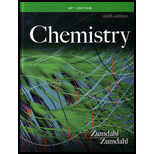
Concept explainers
(a)
Interpretation: The authenticity of the given statements is to be determined.
Concept introduction: Structural isomerism is defined as a form of isomerism in which molecules have the same molecular formula but differ in their bonding patterns and atomic structure.
There are four types of structural isomerism named as: chain isomerism, position isomerism,
To determine: The authenticity of the given statement.
(b)
Interpretation: The authenticity of the given statements is to be determined.
Concept introduction: Structural isomerism is defined as a form of isomerism in which molecules have the same molecular formula but differ in their bonding patterns and atomic structure.
There are four types of structural isomerism named as: chain isomerism, position isomerism, functional group isomerism and tautomerism.
To determine: The authenticity of the given statement.
(c)
Interpretation: The authenticity of the given statements is to be determined.
Concept introduction: Structural isomerism is defined as a form of isomerism in which molecules have the same molecular formula but differ in their bonding patterns and atomic structure.
There are four types of structural isomerism named as: chain isomerism, position isomerism, functional group isomerism and tautomerism.
To determine: The authenticity of the given statement.
(d)
Interpretation: The authenticity of the given statements is to be determined.
Concept introduction: Structural isomerism is defined as a form of isomerism in which molecules have the same molecular formula but differ in their bonding patterns and atomic structure.
There are four types of structural isomerism named as: chain isomerism, position isomerism, functional group isomerism and tautomerism.
To determine: The authenticity of the given statement.
(e)
Interpretation: The authenticity of the given statements is to be determined.
Concept introduction: Structural isomerism is defined as a form of isomerism in which molecules have the same molecular formula but differ in their bonding patterns and atomic structure.
There are four types of structural isomerism named as: chain isomerism, position isomerism, functional group isomerism and tautomerism.
To determine: The authenticity of the given statement.
Want to see the full answer?
Check out a sample textbook solution
Chapter 22 Solutions
CHEMISTRY,AP EDITION-W/ACCESS (HS)
- help 20arrow_forwardProvide the drawing of the unknown structure that corresponds with this data.arrow_forward20.44 The Diels-Alder reaction is not limited to making six-membered rings with only car- bon atoms. Predict the products of the following reactions that produce rings with atoms other than carbon in them. OCCH OCCH H (b) CH C(CH₂)s COOCH མ་ནས་བ (c) N=C H -0.X- (e) H C=N COOCHS + CH2=CHCH₂ →→arrow_forward
- 3) Draw a detailed mechanism and predict the product of the reaction shown? 1) EtMgBr 2) H3O+arrow_forwardHow to draw the mechanism for this reaction?arrow_forward> H₂C=C-CH2-CH3 B. H₂O Pt C. + H2 + H₂O H D. 16. Give the IUPAC name for each of the following: B. Cl Cl c. Cl Cl 17. Draw the line-angle formula for each of the following compounds: 1. phenol 2. 1,3-dichlorobenzene 3. 4-ethyltoluene < Previous Submit Assignment Next ▸arrow_forward
 Chemistry for Today: General, Organic, and Bioche...ChemistryISBN:9781305960060Author:Spencer L. Seager, Michael R. Slabaugh, Maren S. HansenPublisher:Cengage Learning
Chemistry for Today: General, Organic, and Bioche...ChemistryISBN:9781305960060Author:Spencer L. Seager, Michael R. Slabaugh, Maren S. HansenPublisher:Cengage Learning World of Chemistry, 3rd editionChemistryISBN:9781133109655Author:Steven S. Zumdahl, Susan L. Zumdahl, Donald J. DeCostePublisher:Brooks / Cole / Cengage Learning
World of Chemistry, 3rd editionChemistryISBN:9781133109655Author:Steven S. Zumdahl, Susan L. Zumdahl, Donald J. DeCostePublisher:Brooks / Cole / Cengage Learning Introductory Chemistry: A FoundationChemistryISBN:9781337399425Author:Steven S. Zumdahl, Donald J. DeCostePublisher:Cengage Learning
Introductory Chemistry: A FoundationChemistryISBN:9781337399425Author:Steven S. Zumdahl, Donald J. DeCostePublisher:Cengage Learning Introductory Chemistry: A FoundationChemistryISBN:9781285199030Author:Steven S. Zumdahl, Donald J. DeCostePublisher:Cengage Learning
Introductory Chemistry: A FoundationChemistryISBN:9781285199030Author:Steven S. Zumdahl, Donald J. DeCostePublisher:Cengage Learning Introductory Chemistry: An Active Learning Approa...ChemistryISBN:9781305079250Author:Mark S. Cracolice, Ed PetersPublisher:Cengage Learning
Introductory Chemistry: An Active Learning Approa...ChemistryISBN:9781305079250Author:Mark S. Cracolice, Ed PetersPublisher:Cengage Learning





